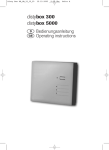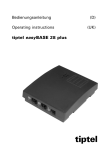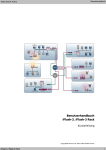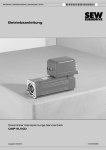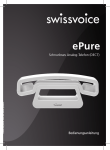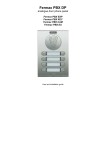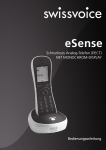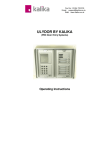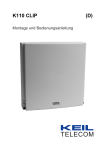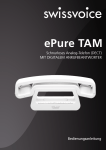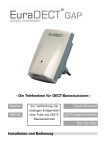Download ba-DECT Box-d-uk_ba-DECT Box-d-uk.qxd
Transcript
Bedienungsanleitung Operating instructions (D) (UK) tiptel DECT Box 300 CLIP/5000 CLIP tiptel Inhaltsverzeichnis Inhaltsverzeichnis Wichtige Information ..................................................2 Anschlüsse und Anzeigen...........................................3 Hörtöne .......................................................................4 1 Inbetriebnahme...........................................................5 1.1 Montage ..........................................................................5 2 Einbuchung /Programmierung ....................................6 2.1 Automatisches Einbuchen ..............................................6 2.2 Programmiermodus.........................................................6 2.2.1 Programmiermodus aktivieren ........................................7 2.2.2 Parametereinstellung im Programmiermodus ................8 2.2.3 Parameterverzeichnis und Lieferzustand ......................16 3 Telefonieren ..............................................................17 3.1 Nach intern telefonieren................................................17 3.2 Nach extern telefonieren...............................................18 Anhang Technische Daten / Zulassung / CE-Zeichen / Reinigung / Gewährleistung / Service 1 Informationen Wichtige Informationen Die DECT Box ist ein universell einsetzbarer, schnurloser Adapter (DECT-Standard) für den Betrieb analoger Endgeräte an GAP-fähigen DECT-Systemen. Diese „schnurlose Verlängerungsleitung“ erspart Ihnen aufwändige Verkabelungsarbeiten und kann an jeder handelsüblichen DECT/GAP-Basisstation wie ein zusätzliches Mobilteil eingebucht werden. Sie können analoge Telefone, Faxgeräte, Anrufbeantworter, Türsprechstellen oder Modem mit Hilfe der DECT Box an Ihre DECT-Basisstation anschließen. Das Gerät muss mit DTMF-Wahlverfahren (MFVWahlverfahren, Tonwahl) arbeiten. Endgeräte, die nur Impulswahl (IWVWahlverfahren, Pulswahl) unterstützen, können an der DECT Box nicht verwendet werden. Bitte prüfen Sie in diesem Falle, ob Ihr Gerät auf DTMF-Wahlverfahren umgeschaltet werden kann. Die DECT Box 300 besitzt eine integrierte Antenne und hat eine DECTübliche Reichweite von bis zu 30 m im Gebäude und bis zu 300 m im Freifeld. Die DECT Box 5000 erfordert den Anschluss einer externen Antenne. Abhängig von der benutzten Basisstation, der Antenne und den allgemeinen Umgebungsbedingungen können erheblich größere Distanzen überbrückt werden. Durch die Verwendung einer externen Antenne an der Basisstation bzw. eines DECT-Repeaters mit externer Richtantenne können maximale Reichweiten von bis zu 10 km realisiert werden. Damit der optimale Betrieb an unterschiedlichen Basisstationen möglich wird, muss die DECT Box eventuell durch Einstellung verschiedener Parameter an die Basisstation angepasst werden. Siehe dazu Kapitel „Programmiermodus“. Durch die unterschiedliche Funktionalität verschiedener Basisstationen können sich bei der Bedienung Abweichungen ergeben. Bitte beachten Sie die Bedienungsanleitung Ihrer Basisstation. HINWEIS Im Lieferzustand ist die DECT Box für den Betrieb an einer Basisstation mit analogem Anschluss eingerichtet, so dass sie in vielen Fällen nicht weiter angepasst werden muss. Für den Betrieb an Basisstationen mit ISDN-Telefonanschluss muss im Programmiermodus der Parameter 40 umgeschaltet werden! 2 Anschlüsse und Anzeigen Anschlüsse und Anzeigen Rückseite 220V/230V 50 Hz DECT Box 5000 Telefon, Anrufbeantworter, Faxgeräte 1 2 Stromversorgung Steckernetzgerät HINWEIS Nach dem Einstecken des Steckernetzgerätes muss der Hörer des angeschlossenen Telefons mindestens 30 Sekunden aufgelegt bleiben! HINWEIS Verwenden Sie nur das mitgelieferte Steckernetzgerät! Vor Öffnen des Gehäuses unbedingt Steckernetzgerät ziehen! 3 Leuchtanzeige (LED) Zeitintervall 8 Sek. LED an LED aus keine Stromversorgung betriebsbereit / Stromversorgung (220 / 230 V) vorhanden / Gerät ist an einer Basis registriert und angemeldet Anruf steht an bestehende Gesprächsverbindung Programmiermodus (Menü) Basis wird gesucht Basis gefunden Keine Basis 3 Anschlüsse und Bedienelemente HINWEIS 4 Line-Anschluss Anschluss für Telefon, Faxgerät, Anrufbeantworter oder Modem. Die RJ 11 Buchse ist auf den beiden mittleren Anschlüssen belegt (Pin 3 und 4). 5 Antennenanschluss (nur DECT Box 5000) SMA Antennenbuchse für den Anschluss einer externen Antenne. Die Verwendung eines hochwertigen Antennenkabels und eine möglichst geringe Kabellänge minimiert Leistungsverluste und optimiert die Reichweite! Hörtöne (im Hörer oder Lautsprecher) Darstellung der Töne Ton Wählton (Dauerton) Sonderwählton (400/425 Hz, Dauerton) Besetztton (425 Hz, wiederholt) Positiver Quittungston (einmalig) Negativer Quittungston (einmalig) 4 Pause 1 Inbetriebnahme 1.1 Montage Standortauswahl Die DECT Box ist für Wandmontage in geschlossenen Räumen ausgelegt. HINWEIS Beachten Sie dabei bitte, dass Sie das Gerät nicht in unmittelbarer Nähe von anderen elektronischen Geräten wie z. B. HiFi-Anlagen, Büromaschinen oder Mikrowellengeräten anbringen sollten. Sie vermeiden damit eine gegenseitige Beeinflussung. Der Aufstellungsort sollte auch nicht in der Nähe von Wärmequellen gewählt werden (z. B. Heizkörper oder direkte Sonneneinstrahlung). Um im Verbindungszustand Störgeräusche zu vermeiden, sollte das angeschlossene Endgerät nicht näher als 1 Meter zur DECT Box aufgestellt werden. Funkausbreitung Die DECT Box muss eine Funkverbindung zur DECT-Basisstation herstellen. Vor der endgültigen Festlegung des Montage-Standortes prüfen Sie bitte, ob der von Ihnen gewünschte Ort innerhalb der Reichweite der DECT-Basisstation liegt. Aufgrund der digitalen Übertragung im benutzten Frequenzbereich kann es - je nach den baulichen Gegebenheiten - auch innerhalb der angegebenen Reichweite zu Abschattungen der Funkwellen kommen. Hierdurch wird die Übertragungsqualität eingeschränkt. Schon eine geringfügige Standortänderung stellt aber die gewohnte Übertragungsqualität wieder her. Da die DECT Box wie ein Mobilteil Ihrer DECT -Basisstation arbeitet, können Sie mit Hilfe Ihres Mobilteils prüfen, ob der Montagestandort geeignet ist. Wandbefestigung Die folgenden Arbeitsschritte sind nötig, um die DECT Box zu montieren: 1. Bohren Sie im Abstand von 60 mm zwei Löcher mit einem Durchmesser von 6 mm in die Wand. 2. Setzen Sie die Dübel ein und drehen Sie die Schrauben bis ca. 5 mm Abstand zur Wand ein. 3. Verbinden Sie die externe Antenne mit dem entsprechenden Anschluss (nur DECT Box 5000). 4. Verbinden Sie Ihr Endgerät mit der DECT Box. 5. Verbinden Sie die DECT Box mit der Stromversorgung. 6. Hängen Sie die DECT Box ein. 5 Antennenanschluss (nur DECT Box 5000) 2 Einbuchung/Programmierung Die DECT Box muss in Ihre DECT-/GAP-Basisstation eingebucht werden, bevor sie benutzt werden kann. Die Einbuchung kann im Regelfalle mit der Funktion „automatisches Einbuchen“ durchgeführt werden. Der „Programmiermodus“ bietet die Möglichkeit, verschiedene Parameter einzustellen, um die DECT Box der Funktionalität Ihrer Basisstation anzupassen. Zusätzliche Parameter erlauben die Einstellung der DECT Box auf Ihre persönlichen Anforderungen. Weiterhin können Sie hier die manuelle Einbuchung durchführen. 2.1 Automatisches Einbuchen Das automatische Einbuchen der DECT Box ist möglich, solange sie noch nicht an einer Basisstation angemeldet ist. Voraussetzung dafür ist, dass die PIN Ihrer Basisstation auf „0000“ oder „1111“ eingestellt ist. 1. Verbinden Sie das Steckernetzgerät mit Ihrer DECT Box. 2. Verbinden Sie Ihr Telefon mit der DECT Box, lassen Sie den Hörer aufgelegt. 3. Stellen Sie sicher, dass Ihre Basisstation die Möglichkeit bietet, ein weiteres Mobilteil anzumelden. 4. Während des Einbuchvorganges sollte sich die DECT Box in der Nähe Ihrer Basisstation befinden. 5. Starten Sie die Anmeldeprozedur an Ihrer DECT-/GAP-Basisstation, so als wollten Sie ein zusätzliches Mobilteil anmelden. Die Beschreibung des Bedienablaufes finden Sie in der Anleitung Ihrer Basisstation. 6. Stecken Sie das Steckernetzgerät in eine Steckdose. Der Einbuchvorgang wird automatisch gestartet. 7. Den erfolgreichen Abschluss des Einbuchvorganges erkennen Sie daran, dass die LED in Abständen von ca. 10 sec kurz aufleuchtet. HINWEIS Sollte der Einbuchvorgang innerhalb von ca. 3 Minuten nicht erfolgreich abgeschlossen sein, führen Sie die manuelle Einbuchung im Programmiermodus durch. 2.2 HINWEIS Programmiermodus Der Programmiermodus der DECT Box kann nur innerhalb der ersten 10 Minuten nach Stecken des Netzteils aktiviert werden. Dadurch wird eine versehentliche Veränderung der Parameter im laufenden Betrieb verhindert.Nicht alle hier angebotenen Leistungsmerkmale 6 2 Einbuchung/Programmierung werden von jeder DECT/GAP-Basisstation unterstützt. Klären Sie mit Hilfe der Bedienungsanleitung Ihrer Basisstation, welche Leistungsmerkmale Sie nutzen können. 2.2.1 Programmiermodus aktivieren Um die DECT Box in den Programmiermodus zu bringen, gehen Sie wie folgt vor: 1. Verbinden Sie Ihr Telefon mit der DECT Box. 2. Verbinden Sie das Steckernetzgerät mit Ihrer DECT Box. 3. Stecken Sie das Steckernetzgerät in eine Steckdose. Lassen Sie den Hörer Ihres Telefons mindestens 30 Sekunden aufgelegt. 4. Heben Sie den Hörer Ihres Telefons ab. Abhängig davon, ob Ihre DECT Box schon in eine Basis eingebucht ist oder nicht, hören Sie einen Besetztton oder einen Wählton. 5. Geben Sie über Ihr Telefon ein: * * 9 . 6. Sie hören einen positiven Quittungston. 7. Optional: Geben Sie über Ihr Telefon die PIN der DECT Box ein. HINWEIS Die Eingabe der PIN ist nur notwendig, wenn zuvor im Programmiermodus eine PIN, abweichend vom Lieferzustand, eingerichtet wurde. Durch die PIN kann der Zugang zum Programmiermodus geschützt werden. 8. Sie hören den Sonderwählton, der Programmiermodus ist aktiviert. Jetzt können Sie durch Eingabe der Parameterkennzahlen die entsprechenden Leistungsmerkmale Ihrer DECT Box verändern. Beispiel Sie möchten Ihre DECT Box an einer Basisstation mit einem ISDNTelefonanschluss benutzen. Aktivieren Sie den Programmiermodus wie oben in Punkt 1-8 beschrieben. Dann: 9. Geben Sie die Programmierkennzahl zur Einstellung „Anschluss an ISDN-/Analog-Leitung ein: 4 0 10. Geben Sie zum Aktivieren des Leistungsmerkmals ein: 0 # 11. Sie hören einen positiven Quittungston und anschließend wieder den Sonderwählton. Das Leistungsmerkmal ist aktiviert. 7 2 Einbuchung/Programmierung 2.2.2 Parametereinstellung im Programmiermodus HINWEIS Nicht alle hier angebotenen Liestungsmerkmale weden von jeder DECT-/ GAP-Basisstation unterstützt. Klären Sie bitte mit Hilfe der Bedienunsanleitung Ihrer Basisstation, welche Leistungsmerkmale Sie nutzen können. Um diese Parameter einzustellen, muss vorher der Programmiermodus aktiviert werden. Die Programmierung einer Funktion wird durch Eingabe von # abgeschlossen und durch den positiven Quittungston bestätigt. Anschließend hören Sie wieder den Sonderwählton und können mit der Programmierung weiterer Funktionen fortfahren. Die Änderung wird mit Ausnahme der Programmierpunkte 90, 91 und 99 ohne Neustart der DECT Box wirksam. Wird während der Programmierung ein ungültiger Wert eingegeben, erfolgt ein negativer Quittungston, die Prozedur wird abgebrochen und Sie hören wieder den Sonderwählton. Erfolgt während der Programmierung innerhalb einer Minute keine Eingabe, so wird die Prozedur abgebrochen und Sie hören wieder den Sonderwählton. Durch Auflegen des Hörers wird jederzeit der Programmiermodus beendet, die DECT Box befindet sich wieder im Normalbetrieb. Funktion Parameter- Weitere Eingaben kennzahl Manuelles Einbuchen der DECT Box 1 Basis PIN # Zum Einbuchen der DECT Box muss die PIN der Basisstation eingegeben werden. Es wird eine 0- bis 8-stellige PIN von der distybox akzeptiert. Nach Eingabe der # hören Sie einen positiven Quittungston. Legen Sie den Hörer nicht auf, bis der Einbuchvorgang abgeschlossen ist und Sie wieder den Sonderwählton hören. Sollte das Einbuchen nicht innerhalb von ca. 3 Minuten abgeschlossen sein, überprüfen Sie bitte die Einstellungen der Basis und starten den Einbuchvorgang erneut. Durch die vierstellige PIN kann der Zugang zum Programmiermodus geschützt werden. 8 2 Einbuchung/Programmierung Funktion Parameter- Weitere Eingaben kennzahl PIN ändern 2 neue PIN neue PIN # Die Eingabe der PIN ist nur notwendig, wenn zuvor mit diesem Progammierpunkt eine PIN, abweichend vom Lieferzustand eingestellt wurde. Zum Ändern der PIN aktivieren Sie den Programmiermodus, geben zweimal die neue PIN ein und bestätigen mit der #. Die Änderung wird durch den positiven Quittungston bestätigt. Jetzt ist ein erneuter Zugang zum Programmiermodus nur noch nach Eingabe der neuen PIN möglich. HINWEIS Bei vergessener PIN kann die DECT Box nur durch den Service zurückgesetzt werden. Lieferzustand: 0 0 0 0 Distanz (nur DECT Box 5000) 3 Distanzwert # Gültige Eingaben sind: 0 — 79. Lieferzustand: 0 Der Einstellwert kann mit Hilfe folgender Berechnungsformel gefunden werden: Distanzwert = Entfernung [in m] geteilt durch 130 Beispiel: 2300 m : 130 m = 17,69 -> Distanzwert = 18 Diese Einstellung wird nur vorgenommen, wenn die Entfernung zwischen der DECT Box und der Basis größer als ca. 800 m ist. Bei kürzeren Entfernungen bleibt der Lieferzustand erhalten. Abhängig von der benutzten Basis kann es Abweichungen geben. Optimieren Sie den Distanzwert in Schritten von 2. Lieferzustand: 0 Anschluss an ISDN-/ analoge Leitung 40 0# Diese Einstellung benutzen Sie, wenn Ihre Basisstation an eine ISDN-Telefonleitung angeschlossen ist. Wahlziffern werden als Keypad-Information gesendet. Im Verbindungszustand werden Keypad-Informationen unterdrückt, damit ist die Übertragung von MFV-Signalen zur Steuerung von externen Geräten möglich. 40 1# „Keypad-Information unterdrücken“, diese Einstellung benutzen Sie, wenn Ihre Basisstation an eine analoge Telefonleitung angeschlossen ist. 9 2 Einbuchung/Programmierung Funktion Parameter- Weitere Eingaben kennzahl 40 2# Die Keypad-Information wird immer gesendet. Diese Einstellung nutzen Sie auch bei Betrieb der DECT Box mit der DECT Box Duo als Basisstation oder ISDN-Basisstationen. Lieferzustand: 1 Betriebsart Fax / Daten 41 0# Betriebsart „Telefon“, diese Einstellung benutzen Sie, wenn ein Telefon an die DECT Box angeschlossen ist. 41 1# Betriebsart "Fax/Daten", mit dieser Einstellung ist die DECT Box für den Betrieb von Fax oder Datengeräten optimiert. HINWEIS Nicht alle DECT-Basisstationen unterstützen dieses Merkmal, im Zweifelsfalle benutzen Sie die Betriebsart „Telefon“. Lieferzustand: 0 Unmittelbar nach dem Abheben des Hörers wird ein interner Wählton hörbar. Interner Wählton 42 0# Mit dieser Einstellung wird der Wählton unterdrückt. Diese Einstellung ist nicht empfehlenswert, wenn der Parameter 71 auf 0 eingestellt ist. 42 1# Mit dieser Einstellung ist der interne Wählton als Dauerton (425 Hz) hörbar. Diese Einstellung ist sinnvoll, wenn Ihre Basisstation an eine direkte Amtsleitung angeschlossen ist. 42 2# Mit dieser Einstellung ist der interne Wählton als unterbrochener Ton (450 Hz) hörbar. Diese Einstellung ist sinnvoll, wenn Ihre Basisstation an eine Telefonanlage angeschlossen ist, die ebenfalls einen unterbrochenen Wählton generiert. Lieferzustand: 0 10 2 Einbuchung/Programmierung Funktion Parameter- Weitere Eingaben kennzahl Lautstärkeeinstellung 43 1…6 # Hier kann die Hörerlautstärke in Schritten von 3 dB an die Akustik Ihres angeschlossenen Gerätes angepasst werden (1=Min., 6=Max.). Lieferzustand: 5 Rufnummeranzeige / CLIP 44 0# Die Rufnummernübermittlung / CLIP an das angeschlossene Endgerät ist deaktiviert. Die Rufkadenz wird von der Basisstation gesteuert, die Funktion 51 ist außer Betrieb! 44 1# Die Rufnummernübermittlung / CLIP an das angeschlossene Endgerät ist aktiviert. Die Information wird als FSK Typ 1-Signal übermittelt, ist damit also in den meisten Ländern nutzbar. Die Rufkadenz ist in der DECT Box fest eingestellt. 44 2# Die Rufnummernübermittlung / CLIP an das angeschlossene Endgerät ist aktiviert. Die Information wird als MFV-Signal übermittelt, dieses Verfahren wird z.B. in den Niederlanden verwendet. Die Rufkadenz wird von der Basis gesteuert. Lieferzustand: 1 Blockwahl aus 49 0# In diesem Modus wird die Wahl des angeschlossenen Endgerätes auf herkömmliche Weise Ziffer für Ziffer abgesetzt. Blockwahl aktiv 49 1# Im Blockwahl Modus werden die Wahlziffern in der DECT Box 300/ 5000 zunächst zwischen gespeichert. Erst nach Eingabe einer # wird die Rufnummer an die Basisstation übertragen. Dieser Modus ermöglicht die Nutzung an Basisstationen die nur die Blockwahl zulassen, (z.B. Gigaset C590). Für diese Funktion sind Parameter einzustellen: Parameter 49 = 1 Parameter 42 = 1 Parameter 71 = 0 Lieferzustand: 0 11 2 Einbuchung/Programmierung Funktion Parameter- Weitere Eingaben kennzahl Feldstärkemessung 50 # Die aktuelle Feldstärke wird durch die Tonhöhe in 5 Stufen im Hörer wiedergegeben, höchster Ton = bester Empfang. Damit kann die Antenne optimal auf die Basisstation ausgerichtet werden. Mit Hilfe eines CLIP-fähigen Telefons kann die aktuelle Einstellung verschiedener Parameter ausgelesen werden. Parameterabfrage 51 Parameterkennzahl # Nach Eingabe der jeweiligen Parameterkennzahl und Bestätigung mit der # legen Sie den Hörer Ihres Telefons auf. Sie erhalten anschließend einen Anruf von der DECT Box; im Display wird die Parameterkennzahl sowie der aktuelle Status angezeigt. Beispiel: Eingabe * * 9 5 1 3 # , Hörer auflegen, Anruf, Displayanzeige: 3#45 Beschränkung der Verbindung 70 0# Es können kommende und gehende Gespräche geführt werden. 70 1# Es können nur kommende Gespräche geführt werden. 70 2# Es können nur gehende Gespräche geführt werden. Diese Einstellung ist z. B. sinnvoll, wenn Sie eine Türsprechstelle (TFE) an die DECT Box angeschlossen haben, damit Amtsanrufe nicht an der Türsprechstelle klingeln. Lieferzustand: 0 12 2 Einbuchung/Programmierung Funktion Parameter- Weitere Eingaben kennzahl Aufbau der Verbindung 71 0# Verbindungsaufbau Intern/Extern. Es wird erst nach Wahl einer Ziffer entschieden, ob eine Verbindung innerhalb der Basisstation oder nach extern aufgebaut werden soll. Diese Einstellung ist nicht empfehlenswert, wenn der Parameter 42 auf 0 eingestellt ist. 71 1# Verbindungsaufbau Intern. Es wird sofort nach Abheben des Hörers eine interne Verbindung vorbereitet. Es können nur weitere Mobilteile dieser Basisstation angerufen werden, eine Verbindung zur Amtsleitung kann nicht hergestellt werden. Bei Anschluss einer Türsprechstelle kann hiermit eine ungewollte Belegung der Amtsleitung verhindert werden. 71 2# Verbindungsaufbau Extern. Es wird sofort nach Abheben des Hörers eine externe Verbindung vorbereitet. Durch Wählen der entsprechenden Kennziffer können auch interne Mobilteile dieser Basisstation angerufen werden. Lieferzustand: 2 Flashfunktion 72 Einstellwert # Die Flashtastenerkennung (R Taste) der DECT Box kann auf die Flashzeit Ihres angeschlossenen Gerätes eingestellt werden. Entnehmen Sie diese der Bedienungsanleitung Ihres Gerätes, z.B. Flashzeit Ihres Gerätes = 100 ms entspricht Einstellwert = 10. Wird dieser Wert auf 0 gesetzt, erfolgt keine Flash-Signalisierung zur Basisstation. Lieferzustand: 23, entspricht 230 ms Gruppenruf 73 0# Die DECT Box reagiert auf Anrufe, die als "group ring" von der Basis signalisiert werden. 73 1# Die DECT Box reagiert nicht auf Anrufe, die als "group ring" von der Basis signalisiert werden. Lieferzustand: 0 13 2 Einbuchung/Programmierung Funktion Parameter- Weitere Eingaben kennzahl Parknummer einstellen 80 Parknummer # Optional kann der Einbuchvorgang unter Verwendung der max. 15stelligen Parknummer Ihrer DECT Basisstation durchgeführt werden. Diese Vorgehensweise ist sinnvoll, wenn durch weitere aktive DECTBasisstationen der Einbuchvorgang behindert wird. Entnehmen Sie die Parknummer der Bedienungsanleitung Ihrer Basisstation. Lieferzustand: keine Parknummer Parknummer / ARI aktivieren 81 0# Die unter Programmierpunkt 80/85 eingestellte Parknummer/ARI wird beim Einbuchvorgang nicht verwendet. 81 1# Die unter Programmierpunkt 80/85 eingestellte Parknummer/ARI wird beim Einbuchvorgang verwendet. Lieferzustand: 0 ARI-Nummer einstellen 85 31 ARI # An Stelle der Parknummer (siehe Parameter 80) kann die ARI-Nummer zum Einbuchen verwendet werden. Bei der Eingabe wird der ARI-Nummer die Kennung 31 vorangestellt. Lieferzustand: keine ARI-Nummer DECT Box zurücksetzen 90 # Die DECT Box wird in den Lieferzustand versetzt. HINWEIS Die DECT Box ist anschließend nicht mehr an einer Basis eingebucht! Alle bisherigen Einstellungen werden gelöscht. Nach Ziehen / Stecken des Steckernetzteils wird ein Neustart der DECT Box durchgeführt und es kann mit der Neuprogrammierung der DECT Box begonnen werden. 14 2 Einbuchung/Programmierung Funktion Parameter- Weitere Eingaben kennzahl Parameter zurücksetzen 91 # Die DECT Box bleibt an der Basisstation eingebucht, alle anderen Parameter werden in den Lieferzustand versetzt. HINWEIS Nach der Eingabe bitte den Hörer auflegen und 30 Sekunden warten. Die DECT Box führt einen Neustart durch. Auto-Reset 92 0# 92 1# Der Auto-Reset ist nicht aktiv. Der Auto-Reset ist aktiv, die DECT Box führt alle 24 Stunden einen Neustart durch. HINWEIS Alle Einstellungen bleiben unverändert erhalten, eine zu diesem Zeitpunkt bestehende Verbindung wird getrennt. Lieferzustand: 0 Ausbuchen 99 # Die Daten der Basisstation werden aus der DECT Box gelöscht. Alle anderen Einstellungen bleiben unverändert erhalten. HINWEIS Nach Ziehen / Stecken des Steckernetzteils wird ein Neustart durchgeführt und die DECT Box kann wieder neu eingebucht werden. 15 2 Einbuchung/Programmierung 2.2.3 Parameterverzeichnis und Lieferzustand Funktion Kennzahl Lieferzustand Manuelles Einbuchen der DECT Box 1 PIN ändern 2 0000 Distanz (nur DECT Box 5000) 3 0 Anschluss an ISDN-/analoge Leitung 40 0 Betriebsart Fax/Daten 41 0 Interner Wählton 42 0 Lautstärkeeinstellung 43 5 Rufnummernanzeige/CLIP 44 1 Feldstärkemessung 50 Parameterabfrage 51 Beschränkung der Verbindung 70 0 Aufbau der Verbindung 71 2 Flashfunktion 72 23 Gruppenruf 73 0 Parknummer einstellen 80 keine Parknummer/ARI aktivieren 81 0 ARI Nummer einstellen 85 keine DECT Box zurücksetzen 90 Parameter zurücksetzen 91 Auto Reset 92 Ausbuchen 99 16 0 3 Telefonieren Abhängig von Ihrer DECT-Basisstation und der Einstellung Ihrer DECT Box hören Sie, wenn Sie den Hörer des angeschlossenen Gerätes abheben, den Wählton der DECT-Basisstation oder den internen Wählton der DECT Box. 3.1 Nach intern telefonieren Interne Telefonate sind Anrufe zu anderen Mobilteilen, die an derselben Basis eingebucht sind. Eingabe **1 **2 **3 **4 **5 **6 **7 **8 **9 **06 HINWEIS Funktion Internes Mobilteil 1 wird gerufen Internes Mobilteil 2 wird gerufen Internes Mobilteil 3 wird gerufen Internes Mobilteil 4 wird gerufen Internes Mobilteil 5 wird gerufen Internes Mobilteil 6 wird gerufen Internes Mobilteil 7 wird gerufen Internes Mobilteil 8 wird gerufen Internes Mobilteil 9 wird gerufen Interner Sammelruf (wenn von der Basisstation unterstützt) Innerhalb der ersten 10 Minuten nach Neustart der DECT Box wird die Tastenkombination * * 9 genutzt, um den Programmiermodus zu aktivieren. Während dieser Zeit ist das interne Mobilteil 9 nicht erreichbar. Sofern von Ihrer DECT-Basisstation unterstützt, können folgende Funktionen durch Kennzifferneingabe aktiviert werden. Bitte beachten Sie die Bedienungsanleitung Ihrer DECT-Basisstation. Eingabe **0+1 **0+2 **0+3 **0+4 **0+5 **0+7 Funktion INT-Taste R-Taste (Flashtaste) Pause-Taste DTMF-Wahl-Umschaltung Pulse-Wahl-Umschaltung * * 0 wird an die Basis gesendet 17 3 Telefonieren 3.2 Nach extern telefonieren Externe Telefonate sind Anrufe zu Teilnehmern Ihrer Telefonanlage oder zu allen Anschlüssen im öffentlichen Telefonnetz. Sofern von Ihrer DECT-Telefonanlage unterstützt, können folgende Funktionen durch Kennzifferneingabe aktiviert werden. Bitte beachten Sie die Bedienungsanleitung Ihrer DECT-Telefonanlage. Eingabe **0+1 **0+2 **0+3 **0+4 **0+5 **0+7 Funktion INT-Taste R-Taste (Flashtaste) Pause-Taste DTMF-Wahl Umschaltung Pulse-Wahl Umschaltung * * 0 wird an die Basis gesendet 18 Anhang Technische Daten Standard: Frequenzbereich: Sendeleistung: SMA Buchse: Sprachübertragung: Faxbetrieb: Modembetrieb: Wählverfahren: Anschließbare Telefone: CLIP: Arbeitstemperatur: Relative Feuchte: Zulässige Lagertemperatur: Anzeigeeinheit: Abmessungen: Gewicht: Montageort: Spannungsversorgung: Lieferumfang: DECT (Digital Enhanced Cordless Telecommunications), GAP-fähig 1880 MHz bis 1900 MHz 10 mW im Mittel für externe Antenne über Koaxialkabel (nur DECT Box 5000) 32 kbit/s ADPCM Gruppe 3, V.29 maximal mit 9600 bit/s 9600 bit/s maximal DTMF (Tonwahl) max. drei Standardtelefone parallel anschließbar Übertragung über FSK1, Protokoll nach ETSIStandard +10° C bis +40° C 20% bis 75% -10° C bis + 60° C Leuchtdiode (LED) 120 x 100 x 38 mm (B x H x T) 140 g Wandmontage in Innenräumen 10 V AC (0,12 A Ruhestrom, 0,4 A maximal), alternativ 12 V DC +/- 15% = 10,2-13,8V (0,12 A Ruhestrom, 0,4 A maximal) Steckernetzteil, 230 V ~, 50 Hz, optional Anschlussadapter Zulassung /CE-Zeichen Hiermit erklärt die Tiptel.com GmbH Business Solutions, dass das Gerät alle grundlegenden Anforderungen der europäischen Richtlinie 1999/5/EG erfüllt. Die Konformität mit dieser Richtlinie wird durch das CE-Zeichen auf dem Gerät bestätigt. Weitere Details zur Konformitätserklärung finden Sie unter folgender Internet-Adresse: http://www.tiptel.de Reinigung Wischen Sie das Gerät einfach mit einem leicht feuchten Tuch oder mit einem Antistatiktuch ab; verwenden Sie bitte kein trockenes Tuch. Vermeiden Sie bitte den Einsatz von Putz- und Scheuermitteln. 19 Anhang Gewährleistung Ihre Ansprechstelle für Leistungen aus Gewährleistungsverpflichtungen ist der Fachhändler, bei dem Sie das Gerät erworben haben. Die Tiptel.com GmbH Business Solutions leistet für Material und Herstellung des Gerätes eine Gewährleistung von 2 Jahren ab der Übergabe. Dem Käufer steht im Mangelfall zunächst nur das Recht auf Nacherfüllung zu. Die Nacherfüllung beinhaltet entweder die Nachbesserung oder die Lieferung eines Ersatzproduktes. Ausgetauschte Geräte oder Teile gehen in das Eigentum des Händlers über. Bei Fehlschlagen der Nacherfüllung kann der Käufer entweder Minderung des Kaufpreises verlangen oder von dem Vertrag zurücktreten. Der Käufer hat festgestellte Mängel dem Händler unverzüglich mitzuteilen. Der Nachweis des Gewährleistungsanspruchs ist durch eine ordnungsgemäße Kaufbestätigung (Kaufbeleg, ggf. Rechnung) zu erbringen. Der Gewährleistungsanspruch erlischt, wenn durch den Käufer oder nicht autorisierte Dritte in das Gerät eingegriffen wird. Schäden, die durch unsachgemäße Behandlung, Bedienung, Aufbewahrung sowie durch höhere Gewalt oder sonstige äußere Einflüsse entstehen, fallen nicht unter die Gewährleistung. Die Gewährleistung umfasst keine Verbrauchsmaterialien (z. B. Batterien) und Mängel, die den Wert oder die Gebrauchstauglichkeit nur unerheblich beeinträchtigen.Durch Transport entstandene Schäden sind bei dem Versandunternehmen geltend zu machen. Hinweis zur Abwicklung: Instandsetzungen erfolgen grundsätzlich nur im Service der Tiptel.com GmbH Business Solutions. Durch unseren 48-Stunden-Instandsetzungsservice erhalten Sie ein Reparaturgerät oder Austauschgerät in der Regel nach 2 Arbeitstagen zuzüglich der üblichen Versandlaufzeiten zurück. Durch eine Gewährleistungsreparatur tritt weder für die ersetzten Teile noch für das Gerät eine Verlängerung der Gewährleistungszeit ein. Diese Gewährleistung ist nicht übertragbar und erlischt, wenn das Gerät in zweite Hand übergeht. Sie erlischt ebenfalls, wenn an dem Gerät von fremder Hand Eingriffe vorgenommen oder die am Gerät befindliche Seriennummer entfernt oder unleserlich gemacht wurde. Das Gerät ist mit einem Gewährleistungssiegel versehen. Bitte achten Sie darauf, dass dieses nicht beschädigt wird, da sonst Ihr Gewährleistungsanspruch ebenfalls erlischt. Ergänzend gelten die allgemeinen Geschäftsbedingungen der Tiptel.com GmbH Business Solutions, die für Ihren Händler Vertragsbestandteil sind. Bei einer Beanstandung ist das defekte Produkt mit einer Fehlerbeschreibung und dem Kaufbeleg einzusenden. Zur Garantieabwicklung wenden Sie sich bitte an Ihren Fachhändler oder senden das Gerät direkt an folgende Anschrift: In Deutschland: Tiptel.com GmbH Service Halskestraße 1 40880 Ratingen In Österreich: Tiptel GmbH Service Ricoweg 30/B1 2351 Wiener Neudorf In der Schweiz: Tiptel AG Service Bahnstrasse 46 8105 Regensdorf Im Garantiefall erfolgt der Rückversand auf Kosten der Tiptel.com GmbH. 20 Anhang Service Sie haben ein modernes Produkt der Tiptel.com GmbH Business Solutions erworben, welches in Deutschland entwickelt und hergestellt wurde. Die hochmoderne Fertigung sichert gleich bleibend höchste Qualität. Dies bestätigt die Zertifizierung nach DIN EN ISO 9001. Sollten trotzdem einmal Probleme auftreten oder haben Sie Fragen zur Bedienung des Gerätes, wenden Sie sich bitte an Ihren Fachhändler. Dieser ist innerhalb der Garantiezeit Ihr Ansprechpartner. Die Tiptel.com GmbH Business Solutions hat für den technischen Support des Fachhandels eine spezielle Rufnummer eingerichtet, so dass dieser Sie qualifiziert beraten kann. Sollte Ihnen Ihr Händler nicht weiterhelfen, können Sie sich auch direkt an die Tiptel.com GmbH Business Solutions wenden. Erste Informationen erhalten Sie auf unseren unten genannten Internetseiten. Außerdem erreichen Sie die erfahrenen Mitarbeiter unseres technischen Supports telefonisch während der angegebenen Zeiten: In Deutschland: In Österreich: In der Schweiz: www.tiptel.de www.tiptel.at 8.00 bis 17.00 Uhr (Mo-Fr) 8.00 bis 17.00 Uhr (Mo-Do) Fr bis 15.00 Uhr Telefon 02236 / 677 464-0 Telefax 02236 / 677 464-21 www.tiptel-online.ch [email protected] 8.00 bis 17.00 Uhr (Mo-Fr) Fr bis 16.00 Uhr Telefon 044 / 884 01 80 Telefax 044 / 843 13 23 Telefon 0900 100 - 84 78 35* Vanity Tel. 0900 100 - TIPTEL* * 1,49 € pro Minute aus dem Festnetz der Deutschen Telekom, abweichende Mobilfunkpreise möglich Fragen zum Telefonanschluss richten Sie bitte an Ihren Netzbetreiber. 21 List of Contents List of Contents Important information ...............................................2 Connections and indicators .......................................3 Tones .........................................................................4 1 Commissioning ..........................................................5 1.1 Mounting ........................................................................5 2 Registration / programming ........................................6 2.1 Automatic registration .....................................................6 2.2 Programming mode.........................................................6 2.2.1 Activating programming mode ........................................7 2.2.2 Setting parameters in programming mode .....................8 3 3.1 3.2 Making telephone calls.............................................15 Making internal calls ..................................................................15 Making external calls .................................................................16 Annex Technical data / Product approval / CE mark / Cleaning / Guarantee 1 2 Informationen Important information The DECT Box is a DECT-standard cordless adapter for universal usage when operating analogue terminals on GAP-compatible DECT systems. Essentially a ”cordless extension cable”, the DECT Box eliminates the need for complicated cabling work and can be registered on any standard DECT/GAP base station just like an extra cordless handset. The DECT Box can be used to connect analogue telephones, fax machines, answering machines, entrance intercoms and modems to your DECT base station. The device must use DTMF dialling (voice frequency signalling); terminals that only support pulse dialling cannot be used on the DECT Box. If your device uses pulse dialling, please check if it can also be switched over to DTMF dialling. The DECT Box 300 features an integrated aerial and has a standard DECT range of up to 30 m indoors and up to 300 m out of doors. An external aerial must be connected to the DECT Box 5000. Much greater distances may be covered, depending on the base station used, the aerial and the general environmental conditions. By using an external aerial on the base station or a DECT repeater with an external directional aerial, a maximum range of up to 10 km can be attained. To ensure optimal operation on different base stations, it may be necessary to modify the DECT Box by setting various parameters on the base station. For more information, see the ”Programming mode” chapter. The varying functionalities of different base stations may, in turn, result in variations in operation. Please observe the instructions for operating your base station. NOTE The factory setting of the DECT Box is for operation on a base station with an analogue connection, which means that in many cases it will not require any further modification. For operation on base stations with an ISDN telephone connection, you will need to switch over parameter 40 in programming mode. 2 Connections and indicators Connections and indicators Backside (easyBOX 5000) 1 220/230V 50 Hz 2 Telephone, answering machine, fax machine 1 2 5 2m 3 4 Power supply Power supply unit (adapter) NOTE After plugging in the power supply unit, the handset on the connected telephone must remain on the hook for at least 30 seconds. NOTE Only the power unit supplied should be used. Before opening the housing, ensure that the power supply unit is disconnected. 3 LED time interval 8 sec LED on LED off No power supply Ready to use/ standby mode / power available (220/ 230 V) / device is registered at a base station Incoming call alert Connection Programming mode (Menu) Search for the base station Found the base station No base station 3 Connections and indicators NOTE 4 Line connection Connection for a telephone, fax machine, answering machine or modem. The RJ-11 socket is assigned to the two middle connections (pins 3 and 4). 5 Aerial connection (DECT Box 5000 only) SMA aerial socket for connecting an external aerial. The use of a high-quality aerial cable and as short a cable as short as possible will minimise any losses in performance and provide the optimum range. Tones Description of the tones Tone Dial tone (continuous) Special dial tone (400/425 Hz, continuous) Busy tone (425 Hz, repeated) Positive acknowledge tone (single) Negative acknowledge tone (single) 4 Pause 1 Commissioning 1.1 Mounting Selecting The DECT Box is designed for wall mounting in interior rooms. a suitable location NOTE Please note that the device must not be fitted in the immediate vicinity of any other electronic devices such as hifi systems, office machines or microwave ovens. This prevents any interference between the devices. In addition, the device should not be installed near heat sources (e.g. radiators or in direct sunlight). To prevent noise interference when making calls, the connected terminal should not be positioned closer than one metre away from the DECT Box. Radio coverage The DECT Box must be able to establish a radio link to the DECT base station. Before determining the final mounting position, you should therefore check that your desired location is within the range of the DECT base station. Owing to the digital transmission in the frequency range used, there may be radiowave ”blind spots” even within the specified range, depending on the nature of the building. This results in a loss of transmission quality. However, just a small change in position will restore normal transmission quality. As the DECT Box works as a cordless unit on your DECT base station, you can use your cordless handset to check whether or not the mounting position is suitable. Wall mounting Follow the steps given below to install the DECT Box 1. Drill two 6 mm diameter holes into the wall at a distance of 60 mm apart. 2. Insert the rawl plug and turn the screws until they are approx. 5 mm away from the wall. 3. Connect the external aerial to the appropriate socket (DECT Box 5000 only). Antenna plug (easyBOX 5000 only) 4. Connect your terminal to the DECT Box. 5. 5. Connect the DECT Box to the power supply. 6. Fit the DECT Box in place. 5 60 mm 2 Registration / programming The DECT Box must be registered on your DECT/GAP base station before it can be used. The registration process can normally be carried out using the ”Automatic registration” function. ”Programming mode” allows you to set various parameters to modify the DECT Box to suit the functionality of your base station. Additional parameters allow the DECT Box to be set according to your personal preferences. Manual registration can also be carried out in this mode. 2.1 Automatic registration The DECT Box can be registered automatically, assuming it has not been registered on any other base station yet. To do this, the PIN on your base station must be set to ”0000” or ”1111”. 1. Connect the power supply unit (adapter) to your DECT Box. 2. Connect your telephone to the DECT Box, leaving the handset on the hook. 3. Ensure that your base station enables an additional cordless phone to be registered. 4. During the registration process, the DECT Box should be located close to your base station. 5. Start the registration procedure for the device on your DECT/GAP base station as if you were registering an additional cordless unit. Instructions on how to do this will be given in the operating manual for your base station. 6. Plug the power supply unit into a power socket. The registration process will be started automatically. 7. The registration process has been successful if the LED flashes at intervals of approx. 10 seconds. NOTE If the registration process has not been completed successfully within approx. 3 minutes, register the device manually in programming mode. 2.2 NOTE Programming mode Programming mode on the DECT Box can only be activated within the first 10 minutes after plugging in the power supply unit. This prevents the parameters being changed accidentally during operation. Not all the features offered by the device are supported by every 6 2 Registration / programming DECT/GAP base station. Refer to the operating manual for your base station to clarify which features you can use. 2.2.1 Activating programming mode Proceed as follows to change the DECT Box to programming mode: 1. Connect your telephone to the DECT Box. 2. Connect the power supply unit to your v. 3. Plug the power supply unit into a power socket. Leave the phone on the hook for at least 30 seconds. 4. Lift the handset on your telephone. Depending on whether or not your DECT Box is already registered on a base station, you will either hear a busy tone or a dialling tone. 5. On your telephone, enter * * 9 . 6. You will hear a positive acknowledgement tone. 7. Optional step: Enter the PIN for the DECT Box via your telephone. NOTE The PIN only needs to be entered if a new PIN has been set up beforehand in programming mode. Access to programming mode can be protected using the PIN! 8. You will hear the special dialling tone indicating that programming mode is active. You can now enter the parameter codes to change the relevant features of your DECT Box. Example Let’s say, for example, you want to use your DECT Box on a base station with an ISDN telephone connection. Activate programming mode as described above in points 1-8 and then proceed as follows: 1. Enter the programming code for connection to an ISDN/analogue line: 40. 2. To activate the feature, enter 0 # . 3. You will hear a positive acknowledgement tone, followed by the special dialling tone once more. The feature is now active. 7 2 Registration / programming 2.2.2 Setting parameters in programming mode NOTE Not all the features offered by the distybox are supported by every DECT/GAP base station. Refer to the operating manual for your base station to clarify which features you can use. Programming mode needs to be activated before this parameter can be set. The function-programming process is concluded by entering # and confirmed by the positive acknowledgement tone. You will then hear the special dialling tone once more, which means that you can continue programming other functions. With the exception of programming points 90, 91 and 99, the change is effective without having to restart the DECT Box. If an invalid value is entered during programming, a negative acknowledgement tone is sounded, the procedure is cancelled and you will hear the special dialling tone once more. If during programming no input is made for one minute, the procedure is cancelled and you will hear the special dialling tone again. Programming mode can be left at any time by replacing the handset; the DECT Box will then return to normal mode. Function Parameter Other input code Manual registration of the DECT Box 1 Base PIN # The base station PIN needs to be entered to register the DECT Box. A PIN with 4 to 8 digits will be accepted by the DECT Box. After entering # you will hear the positive acknowledge tone. Leave the handset off hook and wait until you hear again the special dial tone, which means that the registration is completed. If the registration process has not been completed successfully within approx. 3 minutes, crosscheck the settings of the base station and try again. Access to programming mode can be protected using the four-digit PIN. Changing the PIN 2 new PIN new PIN # Access to programming mode can be protected using the four-digit PIN. The PIN only needs to be entered if a new PIN has been set beforehand in programming mode. To change the PIN, activate programming mode, enter the new PIN twice and confirm this by pressing #. The change is confirmed by the positive acknowledgement tone. Programming mode can then only be accessed again by entering the new PIN once more. If you forget the PIN, the DECT Box can only be reset by the Customer Service department. Factory setting: 0 0 0 0 8 2 Registration / programming Function Parameter Other input code Distance (DECT Box 5000 only) 3 Distance value # Valid entries are 0 - 79. The setting can be determined using the following mathematical formula: Distance value = distance [in m] divided by 130 Example: 2,300 m : 130 m = 17.69 -> distance value = 18 This setting has to be changed only for distances of more than 800 m. For shorter distances the parameter setting will stay on 0. This may vary depending on the base station being used. Adjust the distance value in increments of two. Factory setting: 0 Connection to an ISDN/ analogue line 40 0# Send keypad information, while connection Keypad information will be suppressed, so it is possible to transmit DTMF signals. This setting has to be used if your base station is connected to an ISDN phone line. 40 1# Suppress keypad information: This setting has to be used if your base station is connected to an analogue phone line. 40 2# Send always keypad information. This setting has to be used if your base station is a specified ISDN system. Factory setting: 1 Fax / Data mode 41 0# ”Telephone” Mode: This setting should be used if a telephone is connected to the DECT Box. 41 1# ”Fax” Mode: This setting should be used if a fax machine or modem is connected to the DECT Box. The setting may improve transmission quality. Factory setting: 0 9 2 Registration / programming Function Parameter Other input code Internal dialling tone 42 0# An internal dialling tone is sounded immediately on lifting the handset. The dialling tone is suppressed using this setting. This setting is not recommended if parameter 71 is set to 0. 42 1# With this setting the internal dialling tone is sounded as a continuous tone (425 Hz). This setting is useful if your base station is connected to a direct trunk line. 42 2# With this setting the internal dialling tone is sounded as an interrupted tone (450 Hz). This setting is useful if your base station is connected to a phone system that also generates an interrupted dialling tone. Factory setting: 0 Volume setting 43 1…6 # The handset volume can be adjusted here for the acoustics of your connected device in increments of 3 dB (1 = minimum, 6 = maximum). Factory setting: 5 Display of caller’s number / CLIP 44 0# The caller’s phone number is not transmitted to the connected telephone. The ring cadence of calls is controlled by the base station. Please note: function 51 is not available. 44 1# Display of caller's number/CLIP. For CLIP transmission to the connected phone the FSK type 1 protocol is used, which is common in most countries. The ring cadence is fixed. 44 2# Display of caller's number/CLIP. For CLIP transmission to the connected phone the DTMF protocol is used, which is common in the Netherlands. The ring cadence of calls is controlled by the base station. Factory setting: 1 10 2 Registration / programming Function Parameter Other input code Block dialing off 49 0# This standard mode transmits the dialed number digit by digit from connected analogue device to the DECT Box. Block dialing active 49 1# In Block dialing mode the dialed digits are “queued” in DECT Box 300/5000. Dialing the required number followed by # will result in the dialed number being transmitted in one block to the DECT Box. This enables usage on base stations which are expecting block dialing mode.(Example: Gigaset C590) For this Function please activate Parameters as shown below: Parameter 49 = 1 Parameter 42 = 1 Parameter 71 = 0 Factory setting: 0 Field strength measurement 50 # The current field strength is indicated on the handset by means of five signals of differing pitch, the highest pitch indicating the best reception. This ensures optimum set-up of the aerial for the base station. Parameter query 51 Parametercode # A CLIP-compatible telephone can be used to read the current setting of different parameters. After entering the relevant parameter code and confirming this with #, replace the telephone handset. You will then receive a call from the DECT Box and the parameter code and the current status will be shown on the display. Example: Enter * * 9 5 1 3 # , replace the handset, call, display shows 3#45 11 2 Registration / programming Function Parameter Other input code Limitation of traffic 70 0# Incoming and outgoing calls can be made. 70 1# 70 2# Only incoming calls can be received. Only outgoing calls can be made. This setting is useful, for example, if you have connected an entrance intercom to the DECT Box to prevent exchange calls ringing on the entrance intercom. Factory setting: 0 Connection of calls 71 0# Internal/external call connection. A digit must be dialled to distinguish whether a call is to be connected within the base station or externally. This setting is not recommended if parameter 42 is set to 0. 71 1# Internal call connection. An internal connection is prepared immediately on lifting the handset. Only other cordless units on this base station can be called; no exchange calls are possible. When connecting an entrance intercom, this can be used to prevent the exchange line being seized. 71 2# External call connection. An external connection is prepared immediately on lifting the handset. By dialling the relevant code, internal cordless units on this base station can also be called. Factory setting: 2 Flash function 72 Setting # The flash key detection function (R key) of the DECT Box can be set to the flash time of your connected device. (Please refer to the operating manual for your device for this information). For example, if the flash time of your device is 100 ms, this corresponds to the setting ”10”. The factory setting is 23, which corresponds to 230 ms. 12 2 Registration / programming Function Parameter Other input code Group ring 73 0# The DECT Box responds calls from the base sent as "group ring" calls. 73 1# The DECT Box does not respond calls from the base sent as "group ring" calls. Factory setting: 0 Set PARK number 80 PARK number # As an option, the registration process can be carried out using the PARK number of your DECT base station (PARK = Portable Access Rights Key). This can have up to 15 digits. The procedure is advisable if the registration process cannot be completed due to other active DECT base stations. Please refer to the user’s guide for your base station for further details about PARK numbers. Factory setting: no PARK number set. Activate PARK/ARI number 81 0# The PARK/ARI number set under programming point 80/85 is not used during the registration process. 81 1# The PARK/ARI number set under programming point 80/85 is used during the registration process. Factory setting: 0 Set ARI number 85 31 ARI # Instead of the PARK number (see parameter 80) the ARI number can be used for subscription. For input of the ARI number use 31 as prefix. Factory setting: no ARI number set. 13 2 Registration / programming Function Parameter Other input code Reset DECT Box 90 # The DECT Box is reset to the factory settings. This means, however, that the DECT Box is no longer registered on a base station. All previous settings are deleted. After unplugging / plugging in the adapter, the DECT Box is restarted and reprogramming of the DECT Box can begin. Reset parameter 91 # The DECT Box remains registered on the base station; all other parameters are reset to the factory settings. After entering the parameter, replace the handset and wait for 30 seconds. The DECT Box will be restarted automatically. Auto Reset 92 0# The Auto Reset function is not active. 92 1# The Auto Reset function is active, which means the DECT Box will restart automatically every 24 hours. All settings remain unchanged; any call present at the time of the reset is disconnected. Factory setting: 0 Deregister 99 # The base station data is deleted from the DECT Box. All other settings remain unchanged. After unplugging / plugging in the adapter, an automatic restart is carried out and the DECT Box can be registered on a different base station. 14 3 Making telephone calls Depending on your DECT base station and the setting of your v, you will either hear the DECT base station dialling tone or the internal DECT Box dialling tone when you lift the handset of the connected device. 3.1 Making internal calls Internal phone calls are calls to other cordless phones registered on the same base station. Input NOTE Function **1 **2 **3 **4 **5 **6 **7 **8 **9 Internal cordless unit 1 is called Internal cordless unit 2 is called Internal cordless unit 3 is called Internal cordless unit 4 is called Internal cordless unit 5 is called Internal cordless unit 6 is called Internal cordless unit 7 is called Internal cordless unit 8 is called Internal cordless unit 9 is called **06 Internal hunt group call (if supported by the base station) Within the first 10 minutes after the DECT Box is restarted, the key combination * * 9 can be used to activate programming mode. Internal cordless unit 9 cannot be called during this time. Assuming your DECT base station supports them, the following functions can be activated by entering various codes. Please observe the operating instructions for your DECT base station. Input **0+1 **0+2 **0+3 **0+4 **0+5 Function INT key R key (flash key) Pause key DTMF dial changeover Pulse dial changeover 15 3 Making telephone calls 3.2 Making external calls External phone calls are calls to subscribers on your telephone system or to any connection on the public telephone network. Assuming your DECT telephone system supports them, the following functions can be activated by entering various codes. Please observe the operating instructions for your DECT telephone system. Input **0+1 **0+2 **0+3 **0+4 **0+5 Function INT key R key (flash key) Pause key DTMF dial changeover Pulse dial changeover 16 Annex Technical data Standard: DECT (Digital Enhanced Cordless Telecommunications), GAP-compatible 1880 MHz to 1900 MHz Frequency range: Transmission performance: SMA socket: 10 mW on average For connecting an external aerial via coaxial cable (DECT Box 5000 only) 32 kbit/s ADPCM Group 3, V.29, 9600 bit/s maximum 9600 bit/s maximum DTMF Up to three standard telephones can be connected in parallel Transmission via FSK1; protocol conforms to ETSI standard +10°C to +40°C 20% to 75% Voice transmission: Fax mode: Modem mode: Dialling mode: Connectable telephones: CLIP: Operating temperature: Relative humidity: Permissible storage temperature: Display unit: Dimensions: Weight: Mounting location: Power supply: -10°C to +60°C LED 120 x 100 x 38 mm (W x H x D) 140 g Wall mounting in interior rooms 10 V AC (0.12 A zero signal current, 0.4 A maximum); alternatively, 12 V DC +/- 15% = 10.2-13.8 V (0.12 A zero signal current, 0.4 A maximum) 230 V AC, 50 Hz power supply unit, optional adapter Delivery package: Product approval/CE mark This device is approved for the connection and use within the analogue public telephone networks in all EC countries - according to the European Requirements. Due to technical deviations in individual countries, we cannot grant an unlimited guarantee for the successful operation at all types of telephone accesses. Tiptel hereby declares that the device complies with all fundamental requirements of the European directive 1999/5/EC. This conformity is confirmed by the CE sign on the device. Further details on the declaration of conformity can be found under the following internet address: http://www.tiptel.org Cleaning Simply wipe the device with a slightly damp cloth or with an antistatic cloth; do not use a dry cloth. Do not use cleaning or scouring agents. 17 Annex Guarantee Please contact your local dealer or importer for details of guarantee for non EC countries. Within the European Community the following guarantee regulation applies: Your contact for services arising from guarantee obligations is the authorised dealer where you bought the device. Tiptel.com GmbH Business Solutions will grant a guarantee of 2 years from the date of handover for the material and for the manufacturing of the telecommunications terminal unit. Initially, the purchaser shall have only the right of subsequent performance. Subsequent performance entails either repair or the supply of an alternative product. Exchanged devices or parts shall become the property of the authorised dealer. If the subsequent performance fails, the purchaser can either demand a reduction in the purchase price or withdraw from the contract. The purchaser shall notify the dealer immediately of any defects found. Proof of the guarantee entitlement shall be furnished by standard proof of purchase (receipt or invoice). The guarantee entitlement shall expire if the purchaser or an unauthorised third party interferes with the device. Damage caused by inappropriate handling, operation, storage or by force majeure or other external influences shall not be covered by the guarantee. The guarantee shall not cover any consumable material (e.g. batteries) or defects that only slightly impair the value or the usability of the device. Claims for damage caused by transport shall be asserted to the delivery company. Notes on settlement: Repairs can only be conducted by the Tiptel Service. A warranty repair does not prolong the warranty period - neither for the replaced parts nor for the device. This guarantee is not transferable and shall expire if the device is sold on to another party. It shall also expire if the device is interfered with by third parties or if the serial number on the device has been removed or made illegible. There is a guarantee seal on the DECT Box. Please do not damage or remove this seal because otherwise, your guarantee will expire. The General Terms and Conditions of Tiptel.com GmbH Business Solutions, which are part of the contract for a dealer, shall also apply. In the event of a complaint, the defective product shall be sent to the relevant Tiptel subsidiary, the importer or dealer along with a description of the defect and the proof of purchase. Tiptel.com GmbH Business Solutions, Service, Halskestraße 1, D - 40880 Ratingen Service: You have purchased a modern product of Tiptel granting a continuous level of the highest quality. This is underlined by a certification according to DIN EN ISO 9001. If, however, problems occur or you have questions on operating the device, please contact your local dealer. 18 Tiptel.com GmbH Business Solutions Halskestraße 1 D - 40880 Ratingen Tel.: 0900 100 - 84 78 35* Vanity Tel.: 0900 100 - TIPTEL* Internet: www.tiptel.de International Internet: www.tiptel.com * (1,49 €/Min. aus dem Festnetz der Deutschen Telekom, abweichende Mobilfunkpreise möglich) Tiptel b.v. Camerastraat 2 NL - 1322 BC Almere Telefoon: 0900 - BELTIPTEL of 0900 - 2358478(€ 0,50 p/m, max. € 25,00) Fax: 036 - 53 678 81 E-mail: [email protected] Internet: www.tiptel.nl Tiptel sarl 23, avenue René Duguay Trouin F - 78960 Voisins le Bretonneux Tél : 01 - 39 44 63 30 Fax : 01 - 30 57 00 29 E-mail : [email protected] Internet : www.tiptel.fr Tiptel NV/SA Leuvensesteenweg 510 bus 4 B - 1930 Zaventem Telefoon: 0903 - 99 333 (1,12 Euro/ min) Fax: 02 - 714 93 34 E-mail: [email protected] Internet: www.tiptel.be Tiptel GmbH Ricoweg 30/B1 A - 2351 Wiener Neudorf Telefon: 02236 - 677 464-0 Fax: 02236 - 677 464-22 E-mail: [email protected] Internet: www.tiptel.at Tiptel AG Bahnstrasse 46 CH - 8105 Regensdorf Telefon: 044 - 884 01 80 Fax: 044 - 843 13 23 E-mail: [email protected] Internet: www.tiptel-online.ch 02/10 (D/UK) EDV 4935360
This document in other languages
- Deutsch: Tiptel DECT Box 300 / 5000












































